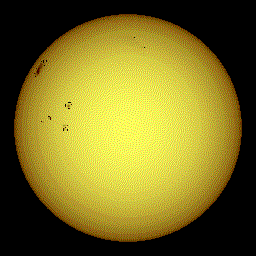

Such measurements show that the Sun does not rotate with the same velocity everywhere : the equator takes about 25 days for one complete revolution, while it takes more than 30 days for areas near the poles. This is not all that strange : contrary to the Earth the Sun is a ball of gas, and therefore there is no reason why it should rotate as a solid body. However, we still do not understand in detail what causes the differences in rotational velocities that we actually measure.
The rotation in the solar interior can of course also be different from that observed at the surface. And one can hope that the information about rotation in the interior will make it easy to understand what is happening at the surface. But how do we measure what goes on inside the Sun ?
It turns out that the frequencies of solar oscillations depend on the solar rotation. Oscillations with m different from 0 corrsepond to running waves that travel around the Sun in longitude, as shown in this film. Oscillations that move in the same direction as the solar rotation will appear to have a frequency that is a little higher, and oscillations that move against the direction of rotation have a frequency that is a little lower. The effect is very similar to the Doppler-effect. Each mode is affected by rotation averaged over a region inside the Sun corresponding to its path of propagation. By combining the results for many oscillations using so-called inversion techniques it is possible to determine the internal rotation rate of the Sun.